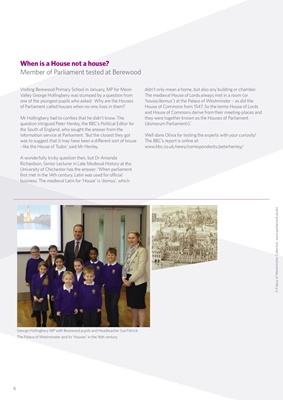
6 Visiting Berewood Primary School in January, MP for Meon
Valley George Hollingbery was stumped by a question from
one of the youngest pupils who asked: Why are the Houses
of Parliament called houses when no-one lives in them?
Mr Hollingbery had to confess that he didn't know. The
question intrigued Peter Henley, the BBC's Political Editor for
the South of England, who sought the answer from the
information service at Parliament. 'But the closest they got
was to suggest that it may have been a different sort of house
- like the House of Tudor,' said Mr Henley.
A wonderfully tricky question then, but Dr Amanda
Richardson, Senior Lecturer in Late Medieval History at the
University of Chichester has the answer: 'When parliament
first met in the 14th century, Latin was used for official
business. The medieval Latin for 'House' is 'domus', which
didn't only mean a home, but also any building or chamber.
The medieval House of Lords always met in a room (or
'house/domus') at the Palace of Westminster - as did the
House of Commons from 1547. So the terms House of Lords
and House of Commons derive from their meeting-places and
they were together known as the Houses of Parliament
(domorum Parliamenti).'
Well done Olivia for testing the experts with your curiosity!
The BBC's report is online at:
www.bbc.co.uk/news/correspondents/peterhenley/
When is a House not a house?
Member of Parliament tested at Berewood
George Hollingbery MP with Berewood pupils and Headteacher Sue Patrick
The Palace of Westminster and its 'Houses' in the 16th century
© Palace of Westminster Collection. www.parliament.uk/art